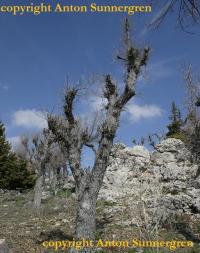Set-up

Among all the trees in the study plot, I randomly chose out 98 of them, almost all were oaks, except for a few ashes. These 98 trees were my control trees. I studied these trees closely by measuring, for example, their circumference, height, distance to neighbouring trees, number of holes etc. and I took a picture of them.
I also walked through the area by random and looking for woodpeckers. When I discovered a middle spotted woodpecker, I decided whether it was foraging in the tree I saw it. If it was foraging I marked the tree and came back to it a day or two later to measure it in the same manner as for the 98 control trees.
When looking for foraging middle spotted woodpeckers I also looked for woodpecker nest holes in the study plot. Except for the middle spotted woodpecker I also looked for white-backed woodpeckers and Syrian woodpeckers (Dendrocopos syriacus) . Now I looked for all three species since the middle spotted woodpecker requires large areas to live in and I would only be able to locate very few middle spotted woodpecker nest holes.
Except from the control group of 98 trees I had a larger control group consisting of 311 trees. To select these trees, I used squares in the study plot. In each square I measured every oak and ash, but I took a lesser amount of parameters for these trees than for the 98 control trees.
Responsible for this page:
Director of undergraduate studies Biology
Last updated:
04/28/08
